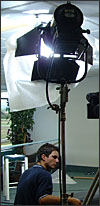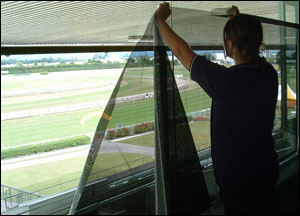Lighting with Background Windows
Shooting pictures indoors with external windows is a common issue for photographers and video makers. The large difference in light levels between the room and the outside view make finding the correct exposure a challenge. Video is particularly susceptible to this problem due to it's relatively low contrast ratio.
If you can't avoid having the window in shot, in most cases the only thing you can do is use the manual iris to set your exposure correctly for the subjects in the room. This means that the window will be over-exposed but that's a necessary compromise. If you wish to show the outside view, expose the iris for the window (which will make the room dark).
If you have time and resources available, there are two things you can do to help even out the lighting so it's possible to capture both areas effectively:
- Add more light to the room
- Reduce the light from the window

(1) Increase the Lighting in the Room
Any extra light you can shine on the subject will decrease the contrast ratio between them and the window.
In some cases switching on the standard room lighting can help, although this often introduces new problems such as clashing colour temperatures and harsh downward shadows.
It's possible that a reflector board could be useful.

(2) Reduce the Light from the Window
You can reduce the amount of light coming through the window by placing some sort of filter over it.
In the example pictured here, black scrim (a fine mesh material) is taped to the window. You can see that the background is much more manageable through the scrim.
If the entire window needs to be in shot you'll need to be careful and discreet with the scrim/filter. It can be difficult getting exactly the right fit. If only part of the window is in shot it's a lot easier.
Filters can cause unwanted side effects such as ripple and the moire effect. Being further away from the window helps.